Sat 6 Mar 2010
A Movie Review by David L. Vineyard: CRACK IN THE WORLD (1965).
Posted by Steve under Reviews , SF & Fantasy films[2] Comments
CRACK IN THE WORLD. Paramount Pictures, 1965. Dana Andrews, Kieron Moore, Janette Scott, Alexander Knox. Screenplay Jon Manchip White & Julian Halevy, based on a story by Jon Manchip White. Director: Andrew Marton.
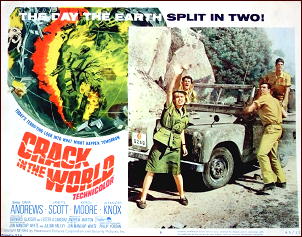
That pretty well sums up this fast paced British science fiction thriller from writer/producer Philip Yordan, director Andrew Marton (King Solomon’s Mines), and Welsh novelist, scholar, folklorist, and screenwriter Jon Manchip White (Nightclimber, The Game of Troy, etc.).
Nobel Prize winner Dr. Stephen Sorenson (Dana Andrews) is dying of cancer and wants one last triumph to benefit mankind in his name, a project to tap into the Earth’s magma core and provide and endless supply of energy and rare metals. His method: deep core drilling, and the use of a thermonuclear warhead to break through the last thin crust before reaching the magma.
Team geologist Dr. Ted Rampion (Kieron Moore) fears the use of the nuclear device will only aggravate cracks in the planets crust caused by nuclear testing. The Macedo Trench, deep beneath the ocean, could break open, a thousand mile wide crack in the world pouring molten lava and magma into the ocean and causing apocalypse.
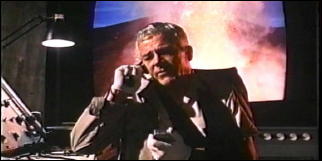
Complicating things are two factors: Sorenson is married to the much younger Maggie (Janette Scott), also a scientist, who was once in love with Rampion, and he is keeping hidden from her — and everyone — that he is dying of cancer.
As Rampion races to London to convince Sir Charles (Alexander Knox) of the UN commission to stop Sorenson’s project, Sorenson pushes through. The missile is fired and all seems well. Rampion is forgiven and returns to the project.
Then his worst nightmares start to come true. The Earth’s crust is beginning to shatter like a windshield hit by a bullet. But if they can set off a second thermonuclear explosion at the right point — a volcanic island on the Macedo Trench — they can use the hydrogen trapped in the magma core to create a backfire and stop the spreading crack in the world.
A capable cast, fine production values and color photography, a literate script, and good direction, plus a melodramatic but appropriate score by John Douglas, contribute to a fast-moving science fiction thriller along the lines of other literate British science fiction films of the period as Five Million Years to Earth, First Men in The Moon, The Day The Earth Caught Fire, and Day of the Triffids (also produced by Yordan with Kieron Moore in the cast). Unlike some other sf offerings of the same general era there is no cheesy acting, zaftig leading ladies, or unfunny comic relief to get in the way.
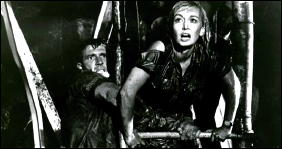
The touch of soap opera is just enough to make this one a bit more adult than the usual sf fare from the period without getting too much in the way of the suspense and excitement. The realistic special effects don’t hurt either. Excellent use of model work, location shooting, and imaginative cinematography all combine to keep the viewer from asking too many questions — which is their role in this kind of film
After the bomb in the Macedo Trench fails, the planet seems certain to be torn apart and sent hurtling in pieces throughout the solar system as twenty thousand square miles of Earth’s surface are torn away — in effect the birth of a new moon, either destroying the planet or saving it by acting as a safety valve.
Andrews is particularly good in this one as a proud man who fears failure more than death and pity more than abandonment. I’m not suggesting it’s an award-winning performance or anything, but it is a deeper and more nuanced than what we usually expect in this kind of film from this period. By this point his career was on the skids, thanks to both drinking and age, but he could still provide a good performance as he does here or in John Sturges’s much underrated The Satan Bug.
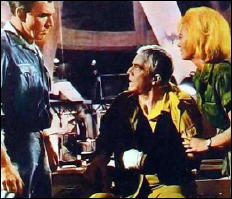
Moore makes for a stalwart leading man, his penchant for playing villains and more complex characters (Mine Own Executioner as the disturbed veteran, the bully in Darby O’Gill and the Little People) adding a little depth to what would other wise be the usual colorless leading man stereotype of these.
Janette Scott is mostly there for eye candy and plot points, but she manages to suggest there might be an actual character there torn between her heart, her mind, her passions, and her needs.
Add some well-done set pieces inside a volcano and a harrowing escape up an elevator shaft into something out of Dante’s inferno, and this one has the factors it needs to hold the attention and provide that sense of wonder that marks the best science fiction on film and in print, and the birth of the new moon is exciting enough for anyone (not that they deal with the problems that would actually cause or the devastating after effects — this was well before anyone suggested the idea of nuclear winter).
Still, this is an attractive little sf film you can enjoy without parking your critical faculties and one that may linger in your imagination longer than you expect.
Note: Of the films mentioned here, The Day The Earth Caught Fire is outstanding, an intelligent sf disaster film told from the point of view of the city desk of a major London newspaper with an outstanding performance by Leo McKern, of Rumpole of the Bailey fame, as a Fleet Street city desk manager worthy of Gerald Kersh’s Bo Raymond stories.
It’s something different than the usual cliches and thrills, with one of the most memorable endings of any sf film of its time.
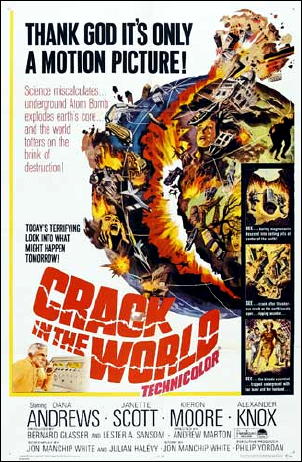
March 7th, 2010 at 10:33 am
David —
Excellent appraisal of this film, much more thorough than my own (necessarily) superficial comments over on Sam Karnick’s American Culture weblog:
http://stkarnick.com/culture/2009/09/20/more-than-one-brain-cell-sf-films-with-ideas-part-thirteen/
CRACK IN THE WORLD is one of those sleeper films that merit more praise than they’ve received.
Yes, the razzle dazzle FX do obscure the scientific implausibilities, but so what? It’s fun!
March 7th, 2010 at 8:18 pm
Mike
Agreed. This one would probably be ridiculous if you thought about it in scientific terms, but the movie wisely never lets you stop long enough to do that.
I’ve always thought this was much better than we had any right to expect, with some nicely handled moments, including a very well handled train wreck near the finale.
Frankly many bigger and better budgeted disaster flics don’t come anywhere near the style and narrative pace of this one. It’s a model of the form.